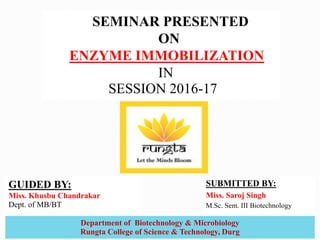
Enzyme immobilization sc
- 1. SUBMITTED BY: Miss. Saroj Singh M.Sc. Sem. III Biotechnology SEMINAR PRESENTED ON ENZYME IMMOBILIZATION IN SESSION 2016-17 1 Department of Biotechnology & Microbiology Rungta College of Science & Technology, Durg GUIDED BY: Miss. Khusbu Chandrakar Dept. of MB/BT
- 2. Introduction Immobilized enzyme Characters Need Carrier Classification of carrier Properties of carrier Methods : 1) Physical methods 2) Chemical methods Choice of immobilized method Advantages Disadvantages Limitations Conclusion Reference 2
- 3. ENZYMES : Enzymes are protein molecule produced by living cells which work as catalyst and speed up chemical reactions. ENZYME IMMOBLIZATION : Generally enzymes are found in free form hence they are not stable and can not be recovered for reuse. Immobilization of enzyme refers to the technique anchoring the enzyme on an inert support for their stability and functional reuse. By employing this technique enzymes become more efficient .It allows enzyme to be held in place during reactions. 3
- 4. Immobilized enzyme is an enzyme that is attached to an inert ,insoluble material . This can provide resistance to changes in conditions such as PH and temperature . CHARACTERS : Attached with a carrier. Stable More efficient . Cost effective Held in place during Reactions. Temperature and PH Resistance. Recovered for reuse after reactions. 4
- 5. CARRIER Carrier is an inert product which attached with enzyme to provide stability and it allows enzymes to be held in place during reactions . 5
- 6. PROPERTIES : 1. Inert or non reactive . 2. Insoluble. 3. Physically strong and stable. 4. Cost effective . 5. Regenerable . 6
- 7. 7
- 8. Physical methods are again of three types depending on the way we immobilize the enzyme they are: 1) Adsorption 2) Entrapment 3) Encapsulation 8
- 9. Adsorption involves the physical binding of enzyme to the surface of an inert support which may be inorganic or organic. Adsorption of enzyme involves weak forces such as Vander walls forces and hydrogen bonds. The adsorbed enzyme can be easily removed by minor changes in PH and temperature. Commonly used support for adsorption are: alumina, silica, charcoal, etc. 9
- 10. ADVANTAGES: The native structure of the enzyme is less disturbed. Preparation is easy. Regeneration of enzyme is possible while it is not possible in cross linking. DISADVANTAGES: The overall enzyme activity is low. Temporary immobilization provided by it. Yield are often low. 10
- 11. Enzymes can be immobilized by physically inside a polymer or a gel. The materials used for entrapping of enzyme include poyacrylamide gel, collagen, gelatin, starch, cellulose, silicon and rubber. In this process may or may not be covalent formation between the enzyme molecules or the matrix. 11
- 12. ADVANTAGES: Cost is low. Industrially useful. can be reused many times. DISADVANTAGES: Preparation is difficult. The enzyme may leak from the pores. Lack of control. 12
- 13. 3). ENCAPSULATION: It involves the enclosing of enzyme in a semipermiable membrane. Membrane is made up of nitrocellulose and nylon. In this process semipermiable membrane work as base which helps to hold enzyme at one place during whole reactions. The membrane should be polymeric, and non ionic in nature. 13
- 14. ADVANTAGES: Native structure of enzyme not disturbed. This method is suitable in medical and health care centers. General applicability is high. DISADVANTAGES: Cost is high. Difficult to prepare. Chance of enzyme leakage 14
- 15. 1). COVALENT BOND: It involve the immobilization of enzyme by creation of covalent bond between the chemical groups of enzymes and the chemical group of carrier. Cellulose, dextrose, agarose are some of the important support in covalent attachment. The choice of support depends upon the surface properties. The support should have functional group to facilitate the attachment 15
- 16. ADVANTAGES : Enzyme activity is high. The strong covalent attachment hold the enzyme tightly. DISADVANTAGES: Cost is high. Preparation is difficult. Regeneration of enzyme is impossible 16
- 17. 2). CROSS LINKING: The absence of a solid support is a characteristic feature of immobilization of enzyme by cross linking. DEAE sephadex , DEAE cellulose ,Dollen 50, caeboxymethyl cellulose and amberlite are the support usually used. 17
- 18. ADVANTAGE : Low cost. Regeneration is possible. Preparation is easy. Overall enzyme activity is high. DISADVANTAGES: Not fit for industrial use. Ionic interaction between substrate and enzyme disturb the enzyme activity. 18
- 19. 1. Suitable for industrial and medical use . 2. Held in place during Reactions. 3. Temperature and PH Resistance. 4. Recovered for reuse after reactions. 5. Enzyme become more efficient. 19
- 20. There are however certain disadvantages also associated with immobilization : The possibility of loss of biological activity of an enzyme. Immobilization is an expensive affair often requiring sophisticated equipment . Some time native structure of enzyme is disrupted due to immobilization. All the enzymes are not immobilized by immobilization. Cost of carriers . 20
- 21. Enzyme immobilization is one of the most promising approaches which used in various fields such as biotransformation , diagnostic , pharmaceutical and also in food industries . Several hundred of enzymes have been immobilized including penicillin and amylase , lipase , protease etc . And are being currently used as catalyst in various large scale process . 21
- 22. Singh B.D. , Text Book Of Biotechnology (Expending Horizon) ,Kalyani publishers , page no. 454 to 461. Satyanarayan U. ,Book Of Biotechnology ,Beliaghata Main Road ( Kolkata ) , page no. 288 to 290 . WWW.Wikipedia.com . And other online sources . 22
- 23. 23